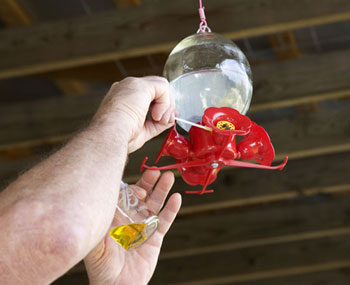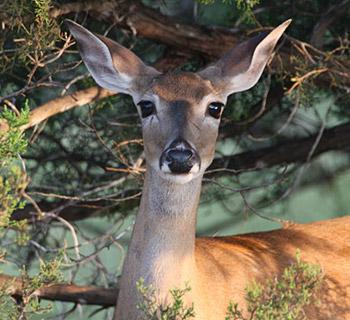- Fewer hummingbirds and bees seen
- Saw Painted bunting
- Saw a duck on the river
- Saw Great Blue heron
- Ceraunus butterfly
- Southern yellow jackets and red wasps were seen hunting caterpillars
- Many frogs and toad tadpoles
- Saw a skink
- Saw a striped racer lizard with no tail
- Saw 2 juvenile Nine-lined racer lizards
- Saw juvenile anole
- Bobcat seen hunting birds at feeding station
Added large juniper stumps around bird feeding area to provide security for small birds and animals and deter deer.
Posted in
2008 Journal, Census, Habitat, Predator
30th

Caretaker's note: Due to colony collapse disorder (CCD), bee populations are declining nationwide. watersto_jennystone caretakers are glad to see healthy populations of bees on the land. However, their competition with hummingbirds over the sugar water in the hummingbird feeders has caused concern for the hummingbirds. The bees are attracted to the color yellow. To deter bees from taking over the feeders, caretakers swab a bit of olive oil on the yellow feeding ports of the hummingbird feeder.
Posted in
2008 Journal, Census, Predator, Food
Edge effect on warblers are harmful with increase in cowbird predation, cats, jays
- Millet brought cowbirds. No more millet
Caretaker's note: An edge is a boundary between a grassland and a woodland. An edge effect occurs when one species predates on another within the edge. For example, predatory species (feral cats, cowbirds, fire ants) will move into the edge of the woodland up to a 100 yards or more. watersto_jennystone's goal in reducing edge effects is to maintain a contiguous dense canopy that is undisturbed with trails or excessive clearing.
Neighbor running chainsaws all day for Ashe juniper removal
Caretaker's note: It is popular for landowners in the Texas Hill Country to remove Ashe juniper. This tree is locally called a "cedar". Myths abound about this much maligned native species. Some believe that the Ashe juniper steals water from other nearby trees and plants. In fact, all trees and plants compete for limited ground water resources. The Ashe juniper is beneficial for many wildlife species: for food, cover and shelter. Poor land management practices over many generations, like overgrazing, have allowed this species to thrive and become aggressive.
The Ashe juniper is a first succession plant, that can grow where almost nothing else can in poor conditions. The thin leaves drop to form soil. Ashe juniper should be managed, but not totally eradicated. This tree is critical to the survival of the endangered Golden-cheeked warbler who uses strips of the easily peeled bark to build its nest. Diversity is a useful goal in any wildlife area and Ashe juniper should never be totally removed. See: Untwisting the Cedar: The myths and culture of the Ashe Juniper tree for more information.
Posted in
2007 Journal, Habitat, Predator
Chiggers!
Caretaker's note: This is a sign that the fire ants are less numerous than before and under control. Have not seen (or felt) chigger bites for 10 years before.
Continued feeding hummingbirds
Caretaker's note: The large 15 ounce feeders do better in the deep shade. Also experimented with city chlorinated water instead of rain water and the feeding solution seemed to last longer.
Saw:
Caretaker's note: Cowbirds are a predatory species on songbirds previously discussed in a 2005 Journal entry. A few have been seen in the spring during nesting season but efforts to find them and shoot them failed. This 2007 photo shows the young cowbirds being introduced to a water source by their adoptive parents, the cardinals. Cowbirds are so named because they tend to be found near cattle operations. Historically, they adapted their predatory behavior to follow buffalo as they roamed to new grazing areas.
- Fox
- Raccoon
- Rock squirrel
- Squirrel
- Deer

Posted in
2007 Journal, Census, Predator, Food, Water
Light scattered rain
Neighbors dog was loose and killed a lizard. It was severely scolded verbally.
Hummingbirds are very active
A chrysalis was found in town on parsley plant. It was removed, transported to watersto_jennystone and put in a net to observe.
Cowbirds:
- Seen at feeders (Brown-headed cowbirds are a parasite in songbirds nests)
- Plan for elimination (shooting if target is in a safe hunting area, also considered building a cowbird trap according to the directions found on TPWD website)
Caretaker's note: Here are some resources from Texas Parks and Wildlife to help landowners deal with cowbirds.
Caution is encouraged in trapping cowbirds, because it is possible to introduce even more cowbirds with a decoy than one might have naturally without the effort.
Posted in
2007 Journal, Census, Predator


